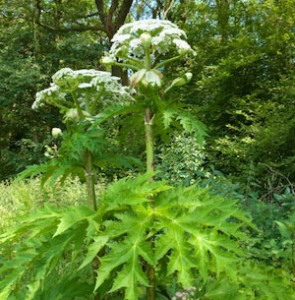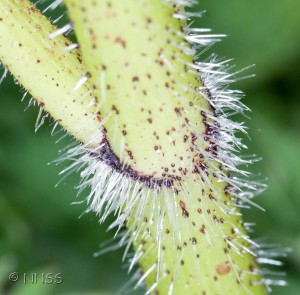The Giant Hogweed – a losing battle?

It seems that the UK is losing the battle to eradicate the giant hogweed. It is an invasive species which has been described as the country’s most dangerous plant. Many efforts have been made to eradicate this plant. Local authorities can make use the Wildlife and Countryside Act 1981 and The Anti-social Behaviour, Crime and Policing Act 2014 to enforce control of the weed. Sadly though Plant Tracker has recorded hundreds of sightings across the four nations of the U.K.
Its scientific name is Heracleum mantegazzianum and it belongs to the same family as the wild parsnip, the Apiaceae. It is sometimes referred to as the giant cow parsnip, the giant cow parsley or the cartwheel flower. It has ‘established’ itself in the UK and it is thought that the recent flooding and warm weather may have helped its spread; its seeds are dispersed by wind - and water being swept along in streams and rivers.
Like the Himalayan Balsam, the giant hogweed is an introduced plant, coming from the Caucasus and Central Asia. It arrived in the U.K. in Victorian times (1819), seed was sent to Kew Gardens from Russia. It was viewed as an ‘ornamental plant’ for gardens. By the end of the Nineteenth Century, it had spread from the gardens and was to be found ‘wild’. it has been illegal to grow the plant in gardens for decades now, as a result of it being highly toxic. The Giant Hogweed is of particular concern because of the risk of phytophotodermatitis. If the sap of the plant comes in contact with the skin (particularly in bright sunlight), it causes itching, reddening, burning and blisters - these can turn to dark / purplish scars that may persist for a long time, A very small amount of the sap can do irreversible damage to the eyes. (to see its effects - visit the NNSS).
 It can grow into a truly massive plant – some fifteen feet (five metres) in height, with leaves (including the leaf stalk) that are some 6 feet (two metres) in length. The stems are thick (10cm), bright green, ridged and have many purple spots (see images below)m they also bear many bristles and hairs at the leaf base. The plant is a perennial (living for 5 – 7 years), but it flowers only once and then dies i.e. it is monocarpic. The giant hogweed’s white flowers form on enormous umbels - the size of dinner plates. A single plant can produce an enormous number of seeds, the number varies from 1500 to 100,000 seeds. Consequently, dense strands of vegetation can form on river banks; displacing native plants and reducing biodiversity in such areas.
It can grow into a truly massive plant – some fifteen feet (five metres) in height, with leaves (including the leaf stalk) that are some 6 feet (two metres) in length. The stems are thick (10cm), bright green, ridged and have many purple spots (see images below)m they also bear many bristles and hairs at the leaf base. The plant is a perennial (living for 5 – 7 years), but it flowers only once and then dies i.e. it is monocarpic. The giant hogweed’s white flowers form on enormous umbels - the size of dinner plates. A single plant can produce an enormous number of seeds, the number varies from 1500 to 100,000 seeds. Consequently, dense strands of vegetation can form on river banks; displacing native plants and reducing biodiversity in such areas.
All images above courtesy of the NNSS Non native species secretariat
Comments are closed for this post.

https://uk.yahoo.com/news/giant-hogweed-dog-essex-pet-191225975.html
E L Wisty
20 March, 2022